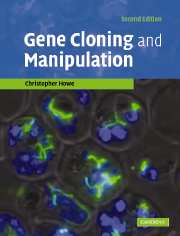Book contents
- Frontmatter
- Contents
- Preface to first edition
- Preface to second edition
- Chapter 1 The tools for the job
- Chapter 2 Polymerase chain reaction
- Chapter 3 Simple cloning
- Chapter 4 Other vector systems for E. coli
- Chapter 5 Making libraries
- Chapter 6 Screening libraries
- Chapter 7 Modification and mutagenesis
- Chapter 8 Use of cloned DNA
- Chapter 9 Using other organisms
- Chapter 10 Examples
- References
- Index
Preface to second edition
Published online by Cambridge University Press: 05 June 2012
- Frontmatter
- Contents
- Preface to first edition
- Preface to second edition
- Chapter 1 The tools for the job
- Chapter 2 Polymerase chain reaction
- Chapter 3 Simple cloning
- Chapter 4 Other vector systems for E. coli
- Chapter 5 Making libraries
- Chapter 6 Screening libraries
- Chapter 7 Modification and mutagenesis
- Chapter 8 Use of cloned DNA
- Chapter 9 Using other organisms
- Chapter 10 Examples
- References
- Index
Summary
The field of gene cloning and manipulation has changed dramatically since the first edition of this book appeared, and this development is reflected in the changes I have introduced in the second edition. The applications of PCR methods have expanded enormously, and “omics” and reverse genetic technologies are available across a wide range of organisms. Significant improvements have also been made in established areas, such as in the hosts and vectors for protein expression, and in the use of fluorescent proteins as reporter genes. As with the first edition, I have tried to stress the principles underlying the vectors we use, and avoid long and detailed lists (which would soon become out of date, anyway). Recognizing the necessity of being able to devise appropriate strategies for individual experimental situations, I have added a final chapter that gives examples and suggestions.
I am grateful to the members of my lab who waited patiently while the pressure of finishing this edition (which became known as my ‘big book of fun’!) delayed other things. I am particularly grateful to the people who helped directly in various ways, especially Mim Bower, Jon Burton, Ellen Nisbet, Saul Purton, Beatrix Schlarb-Ridley, and Petrus de Vries. I would also like to thank Katrina Halliday and Clare Georgy of Cambridge University Press, together with Peter Lewis and Rasika Mathur of Keyword Group for their technical expertise, patience and encouragement.
- Type
- Chapter
- Information
- Gene Cloning and Manipulation , pp. ix - xPublisher: Cambridge University PressPrint publication year: 2007



